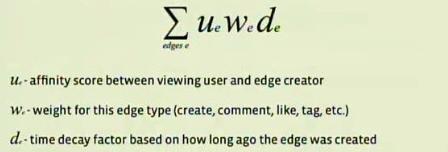Social Media Marketing: Facebook news feed optimization
Much of Facebook’s core functionality centers on its news feed. The constantly updating list of status updates, photos, links and videos helps drive interaction between friends on the network — and between your audience and your brand.
But not all posts are given equal priority in a news feed. Facebook uses a calculation called EdgeRank to determine which updates are prioritized and which are buried.
EdgeRank calculates the “value” of an interaction with a post. Posts with a higher number of valuable interactions are more likely to reach the top of a user’s news feed.
Facebook released the “unweighted” version of its EdgeRank formula at last year’s F8 conference:
A few definitions of Facebook’s terms:
- Object — each item in a news feed is an object. An object can be a written status update, a photo, a video, a link, etc.
- Edge — every interaction with an object is called an edge. This includes comments, likes and tags. As you can see above, some edges are of greater value and more greatly affect EdgeRank.
- Affinity score — when a user regularly messages another user, views their profile, comments on their photos, or interacts in other ways, those interactions increase “affinity” toward that user over time. Users are more likely to see posts that have an “edge” from users for whom they have a higher affinity.
- Time decay — an edge’s value decreases over time.
Focus On Your Audience
Sounds strikingly similar to Google’s PageRank, doesn’t it? You bet. Some marketers are considering which factors drive Facebook’s EdgeRank in hopes of getting more attention to their posts — much like how marketers have worked for years to improve PageRank.
Be careful not to focus too closely on EdgeRank, though. I recently spoke with Justin Kistner, Sr. Manager, Social Media Marketing at Webtrends. Kistner leads product development for Webtrends’ Facebook products. In a recent call, he reiterated that the above calculation is un-weighted and is an “over simplification.”
“For example, we know PageRank for Google could all be boiled down to inbound links. Basically, the more inbound links you have and the better quality links you have, the higher you rank. There is certainly a lot more nuance to the algorithm than just that.”
Not only is the above formula an over simplification, but it is truly secondary to an effective social media marketing strategy. By focusing on the types of content and interactions your audience enjoys, your “objects” will attract more “edges” and will be prioritized in users’ news feeds. Scores and metrics are important to consider — but they should not be the sole driver of your strategy. Your audience, your brand, and your content should be priorities.
Related resources
Social Media Marketing: Online product suggestions generate 10% of revenue
Social Media Measurement: Moving forward with the data and tools at hand
Social Media Measurement: Big data is within reach
Social Media Marketing: Tactics ranked by effectiveness, difficultly and usage
Categories: Social Networking Evangelism Community Branding, Consumer Marketing, content marketing, social marketing, social media










